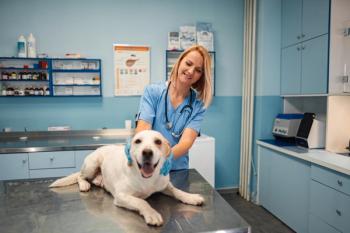
Lyme disease: How to keep pets-and your veterinary clients-safe
Sunny days and a milder winter bring more than an early spring-they may also mean more ticks all over the country. As the threat increases, your role in safeguarding health in your community is more important than ever before.
The past winter, we experienced much-warmer-than-normal temperatures in many areas. With these warmer temperatures, the trees, grass, flowers, and critters came to life in beautiful colors much earlier than normal. Unfortunately, among those critters are mosquitoes and ticks.
We often first see ticks on dogs during the spring months, but I'm betting we will see them much earlier and in greater numbers than we have in previous years—even in places where ticks haven't typically been a problem before. So even if ticks haven't been an issue in your area in the past, you need to be prepared.
Be ready to confidently talk with all clients coming through your doors and answer all of their questions concerning the hows and whys of parasites and the preventive products available. If we don't offer education when clients are in the practice, they may look to the Internet or the teenager working at the local pet store who talks them into using the product of the month on their shelves.
Start with team meetings
To be effective educators, we need to know the details of the disease, be familiar with the testing done concerning these diseases, and know the particulars of the products on our shelves that prevent these diseases. It's important to plan team meetings to discuss the products the veterinarian recommends and why he or she recommends them for each different bug and disease. Then specifically outline the role of the doctor, the technician, the veterinary assistant, the receptionist, the kennel attendant, and the practice manager. We all do better when we know our message and can share it with confidence.
The client needs to hear the same message from every member of the veterinary team. Often a pet owner must hear a message five to seven times before it sinks in. Let's start by reviewing some of the facts about Lyme disease. Then you can plan a team meeting to review this information and implement education strategies within your practice.
A closer look at Lyme disease
Lyme disease is typically seen in dogs. It can occur in cats, but the disease process is not clearly understood in our feline friends. So for the purposes of this article, we will concentrate on dogs.
A dog becomes infected with Borrelia burgdorferi when spirochetes of B. burgdorferi enter connective tissue of the dog from the tick feeding on it. The Eastern black-legged tick (Ixodes scapularis) and the Western black-legged tick (Ixodes pacificus)the are the only two tick species in North America that have been proved to pass the infection to dogs.
The Ixodes species are three-host ticks, which means they feed on animals throughout the life cycle—as larvae, nymphs, and adults. Immature ticks become infected by rodents. The ticks maintain the infection through immature stages and can transmit disease after molting to the nymphal or adult stage. Female ticks do not transfer the infection to newly hatched larvae.
Typically, borreliosis in dogs is seen on the West coast as well as in Northeastern and upper Midwestern states. There is also a higher risk of infection in dogs living in or frequenting tick-infested areas. However, there is always risk no matter where you live or where you've travelled—there are just different levels of exposure risks. The best practice is to recommend that pet owners take precautions and use preventives no matter where they live.
When the infected tick bites the dog, B. burgdorferi enters the connective tissue, leading to infection. It cannot be seen in the blood by means of a microscope, and it is rarely seen in tissue sections. It takes about 24 to 48 hours of feeding before B. burgdorferi can be passed on to a dog—or a human. It is important to note that dogs are not important in maintaining a source of infection. It is very rare for ticks to move back and forth from dogs to people and from people to dogs.
Most dogs don't present with extreme signs when they are exposed to B. burgdorferi. They may have signs that are so mild, the owner and the healthcare team have difficulty noticing the signs. But when dogs suffer from a more severe case of borreliosis, they may present with a fever, enlarged lymph nodes, depression, and lethargy, as well as shifting lameness and swollen joints. In some cases, dogs have had nephropathy that has led to renal failure.
Diagnosing the disease
Diagnosing Lyme disease is complicated. Clinical signs and positive serologic test results for B. burgdorferi help in these efforts but do not result in a definitive diagnosis. Serology is usually done, but because of the long incubation period of four to six weeks, results may be positive if dogs have been exposed or if they have been vaccinated. And dogs that do not show signs in high-risk areas can also have positive test results. This makes it especially difficult to confirm true cases of infection. Enzyme-linked immunosorbent assays and immunofluoresence assays may result in false positive results if a dog has been previously vaccinated or has had prior exposure.
Some assays can identify the presence of antibodies that are caused by true infections vs. vaccine. These are referred to as sensitive and specific patient-side assays. Antibody titers to C6 are the most popular for differentiating vaccine or prior exposure vs. true infection with B. burgdorferi. C6 is a diagnostic peptide based on an invariable region on the VIsE surface protein of B. burgdorferi that has become widely used in serologic testing.
Prevention and zoonotic implications
Vaccines can be a good preventive measure for dogs living in or frequenting tick-infested areas. Vaccination is not warranted if a dog is not commonly in exposure areas. Tick preventives that are highly effective acaricides with residual effects on ticks are strongly recommended for all dogs year-round everywhere. It is also recommended to remove ticks as quickly as possible from dogs with forceps or special tick removal devices.Take care to avoid contact with tick contents by wearing gloves to prevent zoonotic infections. And wash your hands thoroughly and regularly.
You can also help prevent infection in your clients. Lyme disease is the most common vector-borne disease in the United States. This disease in people is similar to the disease in dogs in many ways. Like dogs, people can become infected from single or multiple tick bites from ticks infected with B. burgdorferi. Remind clients to pay close attention to precautionary measures when they head into potentially heavily infested areas. Recommend that pet owners wear light-colored, protective clothing; use repellant products labeled specifically for effectiveness against ticks; check themselves for ticks; and remove ticks as quickly as possible.
Tackle tough tick talks
So now that your team understands the clinical importance of Lyme disease, it's time to get everyone talking to clients about Lyme disease and other parasites. Pet owners need to know all the potential risks and the preventives available for their pets.
Ticks are second only to mosquitoes as vectors of human disease. Prevention and control are important in lowering the risks of Lyme disease and other tick-related diseases. Once again, year-round preventives are hugely responsible for controlling and preventing diseases associated with ticks and other parasites. Even though the weather may be cold or you may be in an area that typically doesn't see ticks, weather variances across the country and the feasibility of ticks surviving in your home in carpeting, bedding, and furniture during those cold months makes prevention more important.
To help your entire team understand the tick-borne disease risks in your area and to help spread the message to clients, the Companion Animal Parasite Council (CAPC) has designed an in-depth prevalence map of parasites and diseases, including Lyme disease occurrences. Visitors to
These maps have also been used by the Centers for Disease Control and Prevention (CDC). The agency has concurred that people living in areas with a higher-than-average number of dogs with Lyme disease are at a higher risk of developing the disease.2 Cross-referencing CAPC prevalence maps with the U.S. national surveillance data reveals the same findings.3
Ultimately, this data can help you educate pet owners and play an even bigger role in the efforts to keep pets and people healthy and protected. Your team shares an important job to educate the public and pet owners about the risks of parasitic diseases. By offering them clear and real information and directing them to trusted resources, we're protecting the health of our clients as well as our patients.
Julie Legred, CVT, is the veterinary technician program specialist for Banfield. She is also the immediate past president of NAVTA and the only technician board member for CAPC.
References
1. Companion Animal Parasite Council. Vector-borne diseases—Lyme disease page. Available at:
2. Mead P, Goel R, Kugeler K. Canine serology as adjunct to human Lyme disease surveillance. Emerg Infect Dis 2011;17(9):1710-1712.
3. Bowman DD. Georgis' parasitology for veterinarians. 9th ed. Philadelphia, Pa: WB Saunders Co, 2008.
Newsletter
From exam room tips to practice management insights, get trusted veterinary news delivered straight to your inbox—subscribe to dvm360.






